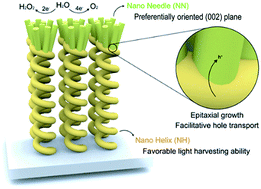Epitaxial growth of WO3 nanoneedles achieved using a facile flame surface treatment process engineering of hole transport and water oxidation reactivity†
Abstract
Charge carrier dynamics and light harvesting ability are most important for the performance of a photoanode in photoelectrochemical (PEC) systems. In this work, through a facile flame surface treatment process in a reducing atmosphere, oriented WO3 nanoneedles are grown on pre-formed vertically aligned nanohelices. Nanohelices have excellent light harvesting abilities on their own; however, the addition of nanoneedles to the top of nanohelices increases the light harvesting abilities even further. More importantly, the reducing atmosphere for the post-treatment process enhances the metallic properties of WO3, changes the band position to facilitate hole transport, and modifies the flat band potential, all of which contribute to an improved performance in terms of photocurrent density and onset. The as-fabricated WO3 nanohelices/nanoneedles with a metallic interface have also been used for heterojunction photoanode fabrication for water oxidation through two- and four-electron pathways for H2O2 and O2 production, respectively.



 Please wait while we load your content...
Please wait while we load your content...